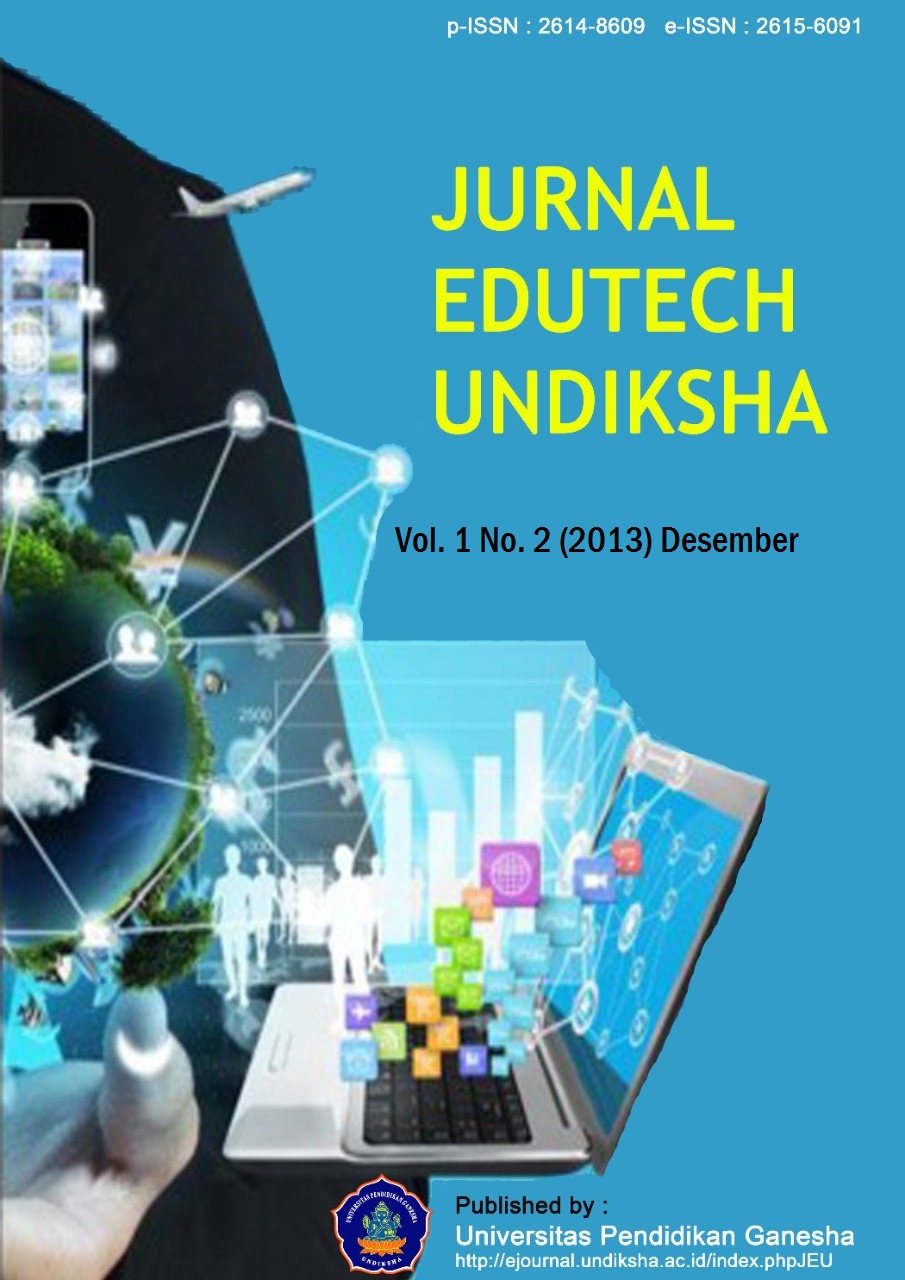Pengaruh Model Pembelajaran Team Assisted Individualization (TAI) Terhadap Hasil Belajar Mata Pelajaran IPA Pada Siswa Kelas VII Tahun Ajaran 2014/2015 di SMP Negeri 1 Banjar
DOI:
https://doi.org/10.23887/jeu.v2i1.4521Abstrak
Penelitian ini bertujuan untuk mengetahui perbedaan yang signifikan hasil belajar IPA antara siswa yang dibelajarkan melalui model pembelajaran Team Assisted Individualization (TAI) dengan siswa yang dibelajarkan melalui pembelajaran konvensional pada kelas VII SMP Negeri I Banjar Tahun Ajaran 2014/2015. Penelitian ini merupakan penelitian eksperimen semu dengan rancangan pretest-posttest dua kelompok (Noneqivalent Control Group Design). Populasi penelitian yaitu seluruh siswa kelas VII di SMP Negeri 1 Banjar yang berjumlah 511 orang, dari 511 orang tersebut didapat 30 orang untuk kelas eksperimen dan 30 orang kelas control. Penentuan sampel dilakukan menggunakan random sampling dengan teknik undian. Data yang dikumpulkan adalah hasil belajar IPA yang didapat dengan menggunakan metode tes jenis objektif pilihan ganda dengan jumlah 30 soal objektif. Data yang dikumpulkan dianalisis menggunakan statistik deskriptif dan statistik inferensial dengan menggunakan rumus uji-t. Hasil penelitian pada siswa yang dibelajarkan melalui model pembelajaran TAI, diperoleh rata-rata hasil belajar IPA sebesar 72,74, dengan hasil belajar yang termasuk kategori sangat baik sebesar 50% = 15 orang, kategori baik sebesar 30% = 9 orang, dan kategori cukup sebesar 20% = 6 orang. Rata-rata hasil belajar IPA siswa yang dibelajarkan melalui pembelajaran konvensional adalah 66,42, dengan hasil belajar yang termasuk kategori sangat baik sebesar 26,66% = 8 orang, kategori baik sebesar 50% = 15 orang, dan kategori cukup sebesar 23,33% = 7 orang. Berdasarkan hasil analisis uji-t diperoleh thitung = 2,34 pada taraf signifikansi 5% dan dk=58, dan ttabel(α=0,05;58)=2,000. Ini berarti thitung>ttabel, maka H0 ditolak. Ini menunjukkan bahwa model pembelajaran kooperatif tipe TAI memberikan pengaruh positif terhadap hasil belajar IPA siswa, yang berarti bahwa hasil belajar IPA siswa yang dibelajarkan melalui model pembelajaran kooperatif tipe TAI lebih tinggi dari hasil belajar IPA siswa yang dibelajarkan melalui pembelajaran konvensional. Jadi dapat disimpulkan bahwa terdapat perbedaan yang signifikan antara hasil belajar IPA siswa yang dibelajarkan melalui model pembelajaran TAI dengan siswa yang dibelajarkan melalui pembelajaran konvensional pada kelas VII SMP Negeri 1 Banjar tahun ajaran 2014/2015.Kata Kunci : Model Pembelajaran TAI, Model Pembelajaran Konvensional, Hasil Belajar, dan IPA.
This study aims to determine significant differences between students' science learning outcomes that learned through learning model Team Assisted Individualization (TAI) with students that learned through conventional learning in class VII Junior High School I Banjar Academic Year 2014/2015. This study was a quasi-experimental study with pretest -posttest two groups (Noneqivalent Control Group Design). The study population is the entire seventh grade students at SMP Negeri 1 Banjar, amounting to 511 people, of the 511 people come to class 30 experimental and 30 control class. The samples made using random sampling techniques lottery. The data collected is science learning outcomes obtained by using the method of multiple choice objective type test with a number of 30 objective questions. The data collected were analyzed using descriptive statistics and inferential statistics using t-test formula. Results of research on students that learned through learning model of TAI, gained an average of 72.74 science learning outcomes, the learning outcomes that are categorized very good by 50 % = 15 people, both categories by 30 % = 9 people, and enough categories 20% = 6. The average results of learning science students that learned through conventional teaching is 66.42, the learning outcomes that include excellent category of 26.66 % = 8, both categories by 50 % = 15 people, and enough category of 23.33 % = 7. Based on the results of t-test analysis obtained t = 2.34 at a significance level of 5 % and df = 58, and TTable ( α = 0.05 ; 58 ) = 2.000. This means tcount > ttable , then H0 is rejected. It shows that the cooperative learning model of TAI a positive impact on students' science learning outcomes, which means that the results of learning science students that learned through cooperative learning model of TAI is higher than the results of learning science students that learned through conventional learning. So it can be concluded that there are significant differences between the results of learning science students that learned through TAI learning model with the students that learned through conventional learning in class VII SMP Negeri 1 Banjar academic year 2014/2015.
keyword : TAI Learning Model, Model Conventional Learning, Learning Outcomes, and Science.
Diterbitkan
2015-01-27
Cara Mengutip
., N. M. C. A. W., ., D. I. I. W. S., & ., D. N. W. (2015). Pengaruh Model Pembelajaran Team Assisted Individualization (TAI) Terhadap Hasil Belajar Mata Pelajaran IPA Pada Siswa Kelas VII Tahun Ajaran 2014/2015 di SMP Negeri 1 Banjar . Jurnal Edutech Undiksha, 2(1). https://doi.org/10.23887/jeu.v2i1.4521
Terbitan
Bagian
Articles
Lisensi
Authors who publish with the Jurnal EDUTECH Undiksha agree to the following terms:
- Authors retain copyright and grant the journal the right of first publication with the work simultaneously licensed under a Creative Commons Attribution License (CC BY-SA 4.0) that allows others to share the work with an acknowledgment of the work's authorship and initial publication in this journal.
- Authors are able to enter into separate, additional contractual arrangements for the non-exclusive distribution of the journal's published version of the work (e.g., post it to an institutional repository or publish it in a book), with an acknowledgment of its initial publication in this journal.
- Authors are permitted and encouraged to post their work online (e.g., in institutional repositories or on their website) prior to and during the submission process, as it can lead to productive exchanges, as well as earlier and greater citation of published work. (See The Effect of Open Access)














